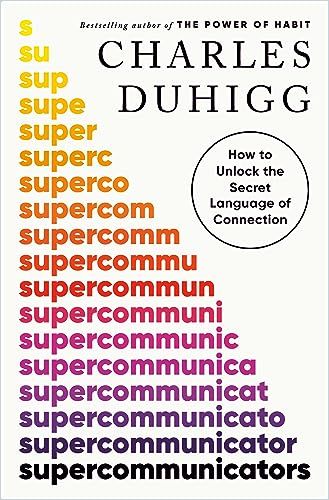Good conversations can build connection, exert influence, and offer immense pleasure — but humans don’t innately know how to hold them. Veteran journalist Charles Duhigg explores the art, skill, and science of conversation in the internet age.

Good Talk
Since ancient times, humans have loved to talk about talking. Cicero, an Ancient Greek statesman and philosopher, set out rules for good conversations. And over the centuries, guidance for good talk hasn’t varied much. Mostly, the advice goes, let others speak, pay attention to what they say, show interest, ask questions, don’t gossip, and don’t talk too much about yourself.
Journalist Charles Duhigg — the best-selling author of The Power of Habit — is a veteran business reporter. A graduate of Yale College and Harvard Business School, he writes for The New Yorker and has served as senior editor at The New York Times. But when Duhigg found himself struggling to communicate and connect with his nearest and dearest, he undertook three years of study to learn how to improve the way he listened and spoke. That research underlies Supercommunicators: How to Unlock the Secret Language of Connection, another of Duhigg’s deep dives into a vital, everyday human activity.
If you listen for someone’s truth, and you put your truth next to it, you might reach them.
Charles Duhigg
Duhigg echoes ancient wisdom on the art of conversation and updates it with recent research in neuroscience, behavioral science, and psychology. Offering fresh insights and recommendations, he centers his discussion on a few simple points: Conversations matter, you can learn to converse better, and certain people — whom Duhigg dubs “supercommunicators” — can show you how.
Making Conversations Count
According to Duhigg, all conversations serve a decision-making, emotional, or social purpose. Identifying the type of conversation taking place will help you gauge the mindset of your conversational partner, find “symmetry,” and avoid a conversational mismatch — which can occur when interlocutors inhabit different mindsets.
When a conversation moves to a decision-making mode, you should focus on listening carefully, evaluating others’ words, and seeking hidden motivations, Duhigg says. Discern whether your conversational partner seeks practical suggestions or merely a listening ear.
Emotional conversations can help you build trust and connection with others, so they’re worth pursuing even if they make you feel slightly uncomfortable. During these conversations, people will feel more connected to you if you acknowledge their vulnerability and display vulnerability yourself. You might be tempted to share a story about yourself in order to show you empathize, but resist this impulse, Duhigg advises, until you hear more about the other person’s situation. Otherwise, you’ll risk demonstrating how little you understand it.
Emotional dialogues are vital because they help us figure out who we’re talking to, what’s going on inside their heads, what they value most.
Charles Duhigg
Duhigg explains that social conversations have an important purpose: to help people define who they are and to establish social identities, which have powerful impacts on people’s thoughts and behavior. Thus, Duhigg advises, be mindful of stereotypes and assumptions when you engage in these conversations. To deepen trust and connection, discuss commonalities that bridge differences — for example, what it means to you and your conversation partner to, say, support the same sports team. Duhigg observes that by asking people about their communities, allegiances, backgrounds, and other aspects of identity, you remind yourself and others that no one is one-dimensional.
Strive to have “learning conversations” — discussions wherein you aim to understand the other person’s point of view and express your opinion. Duhigg proposes four rules for sparking learning conversations: First, pause to evaluate what kind of conversation is unfolding. Unless you and your speaking partner share the same conversational mindset, you won’t connect. Second, reveal what each of you hopes to achieve from the conversation. Do you yearn to be “helped, hugged, or heard”? Third, divulge your feelings and ask about the other person’s feelings. Fourth, discern whether identities are relevant to the discussion.
Forging Connection
Duhigg says the real secret to engaging, productive conversations is creating connections. Supercommunicators don’t necessarily boast dynamism or charisma, but they’re skilled at making people feel comfortable speaking from the heart and sharing their opinions. They also know how to influence without coming across as manipulative. Duhigg discovered that supercommunicators excel in the art of conversation by asking lots of questions, showing interest in others’ thoughts and ideas, and showing humility by confessing to weaknesses and failures. They’re people who laugh at others’ jokes and who can also laugh at themselves.
To communicate with someone, we must connect with them.
Charles Duhigg
To illustrate the ways supercommunicators make people feel comfortable and heard — thereby wielding enormous influence — Duhigg features engrossing accounts of the work of a CIA recruiter, whose job it is to convince reluctant people to risk their lives by becoming informants; of discussions among jurors who have to come to a decision on a knotty case; and of a doctor who persuaded anti-vaxxers to have their children vaccinated during the COVID-19 pandemic. Through these powerful stories, Duhigg shows how supercommunicators rely on creating personal connections and gaining trust to convey a message and influence their interlocutors.
Getting in Sync
Duhigg discusses advances in neuroscience that reveal the underpinnings of conversational connection. Research shows that experiences of being “in sync” with others — such as when musicians feel they’re playing as one or when a conversation flows easily — reflect a phenomenon called “neural entrainment.” Neurally entrained participants’ brain waves become synchronized, their pulses fall into rhythm, and even their pupils will dilate in unison. Neural entrainment “feels wonderful,” Duhigg says, and it explains why good conversation has long been considered a source of enormous pleasure.
If conversation has never been your strong suit, or your attempts at conversing frequently fall flat, Duhigg provides an insightful, empathetic, and research-based guide to conversing with aplomb. In an age of disconnection and rampant loneliness, Supercommunicators offers timeless, and timely, wisdom.






